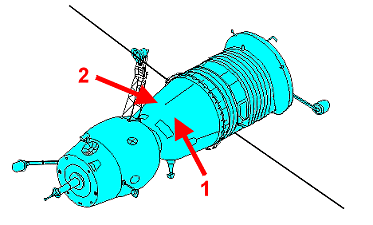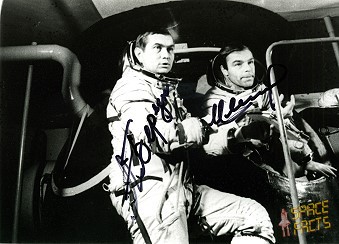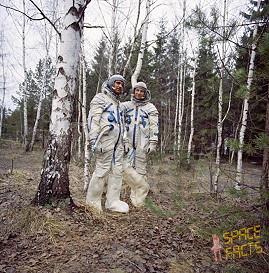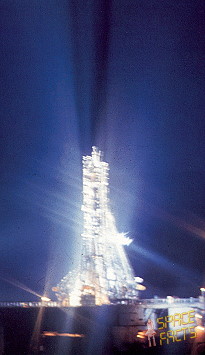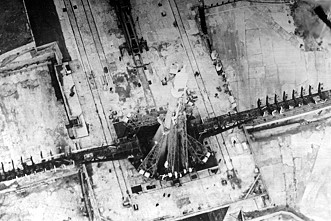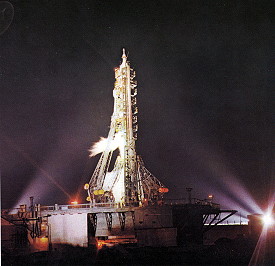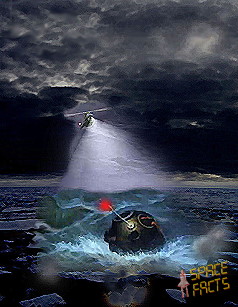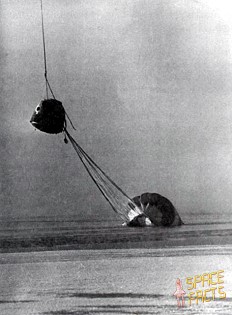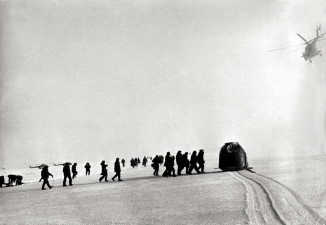Launch from the Baikonur Cosmodrome and
landing 195 km southwest of Tselinograd / 148 km southeast of Arkalyk.
The
Soyuz 23 ferry spacecraft suffered a
docking system
failure. Sensors indicated an incorrect lateral velocity, causing
unnecessary firing of the thrusters during rendezvous (approach was until 100
m). The automatic system was turned off, but no fuel remained for a manual
docking with the
Salyut 5 space station. Crews were normally trained
for a manual dock, but not for a manual approach. So, the only possible
solution was an immediate return to Earth.
The
Soyuz spacecraft is composed of three elements
attached end-to-end - the Orbital Module, the Descent Module and the
Instrumentation/Propulsion Module. The crew occupied the central element, the
Descent Module. The other two modules are jettisoned prior to re-entry. They
burn up in the atmosphere, so only the Descent Module returned to Earth.
The
deorbit burn lasted 188 seconds. Having shed two-thirds of its mass, the
Soyuz reached Entry Interface - a point 400,000 feet
(121.9 kilometers) above the Earth, where friction due to the thickening
atmosphere began to heat its outer surfaces. With only 23 minutes left before
it lands on the grassy plains of central Asia, attention in the module turned
to slowing its rate of descent.
Eight minutes later, the spacecraft was
streaking through the sky at a rate of 755 feet (230 meters) per second. Before
it touched down, its speed slowed to only 5 feet (1.5 meter) per second, and it
lands at an even lower speed than that. Several onboard features ensure that
the vehicle and crew land safely and in relative comfort.
Four parachutes,
deployed 15 minutes before landing, dramatically slowed the vehicle's rate of
descent. Two pilot parachutes were the first to be released, and a drogue chute
attached to the second one followed immediately after. The drogue, measuring 24
square meters (258 square feet) in area, slowed the rate of descent from 755
feet (230 meters) per second to 262 feet (80 meters) per second.
The main
parachute was the last to emerge. It is the largest chute, with a surface area
of 10,764 square feet (1,000 square meters). Its harnesses shifted the
vehicle's attitude to a 30-degree angle relative to the ground, dissipating
heat, and then shifted it again to a straight vertical descent prior to
landing.
The main chute slowed the
Soyuz to a descent rate of only 24 feet (7.3 meters)
per second, which is still too fast for a comfortable landing. In a normal
landing one second before touchdown, two sets of three small engines on the
bottom of the vehicle fired, slowing the vehicle to soften the landing.
The
spacecraft experienced a remarkable and near catastrophic return to Earth. The
crew landed at night on a frozen lake (Tengiz) during a snow-storm (195
km southwest of Tselinograd / 140 km southeast of Arkalyk). The ice broke, the
parachute became wet and took the escape hatch under water. The capsule was
cooled and the heating systems had been turned down to conserve the battery
power.
Several attempts, to reach the capsule, failed. But the capsule's
beacons could not be seen in the heavy fog, and rubber rafts used to try to
reach them were blocked by ice and sludge. Amphibious vehicles were air-lifted
to the vicinity, but could not reach the capsule owing to bogs surrounding the
lake. Accordingly, the rescue was called off until dawn. The cosmonauts were
safe, but they were low on power, so they were forced to shut down everything
but a small interior light. The next morning, frogmen were dropped in by
helicopters, attached flotation devices to the
Soyuz craft and recovered the crew. The capsule was
too heavy to be lifted by the helicopter, so it was dragged to shore. The
recovery operation had taken nine hours. The rescue men were surprised to find
the crew alive.
![]()


![]()

